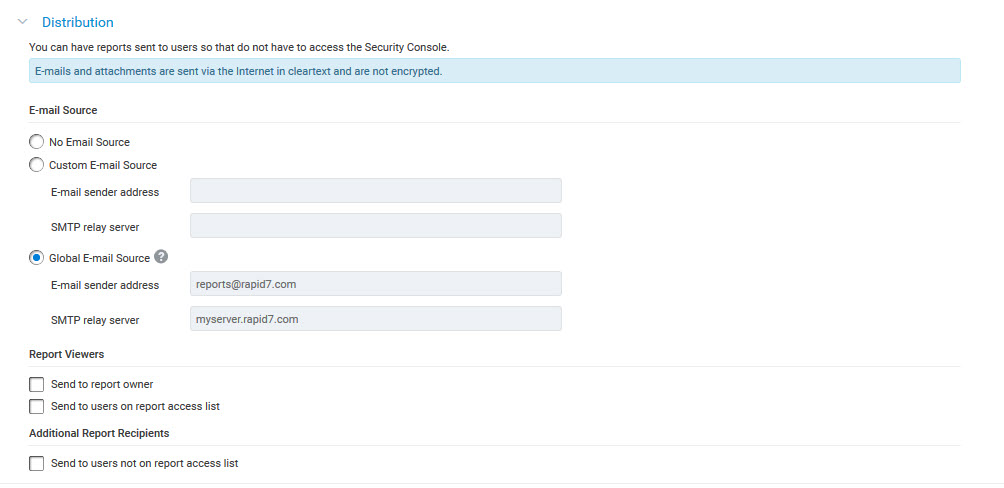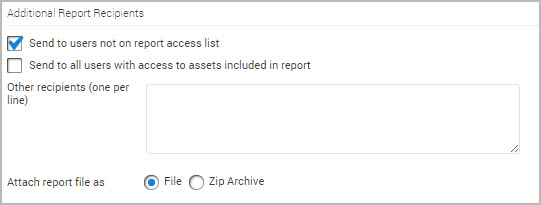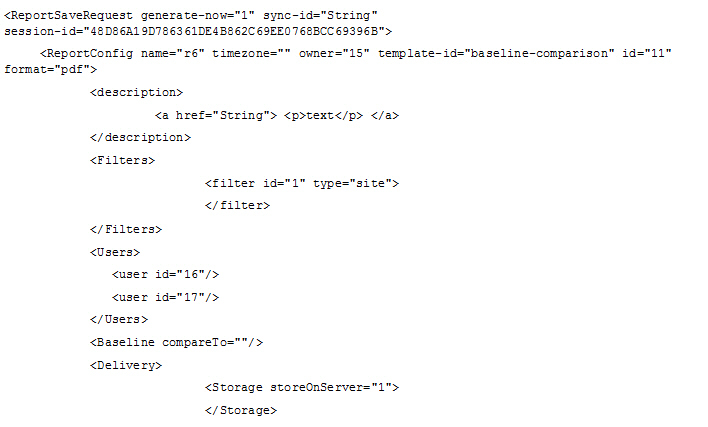Distributing, sharing, and exporting reports
When configuring a report, you have a number of options related to how the information will be consumed and by whom. You can restrict report access to one user or a group of users. You can restrict sections of reports that contain sensitive information so that only specific users see these sections. You can control how reports are distributed to users, whether they are sent in e-mails or stored in certain directories. If you are exporting report information to external databases, you can specify certain properties related to the data export.
Working with report owners
After a report is generated, only a Global Administrator and the designated report owner can see that report on the Reports page. You also can have a copy of the report stored in the report owner’s directory.
If you are a Global Administrator, you can assign ownership of the report one of a list of users.
If you are not a Global Administrator, you will automatically become the report owner.
Reports Do Not Move After Owner Change
If you use “Report File Storage” to create a copy of a report on the Security Console’s file system, changing the owner of a report will not move existing generated reports to the new owner’s folder.
Storing reports in report owner directories
When the application generates a report, it stores it in the reports directory on the Security Console host:
[installation_directory]/nsc/reports/[user_name]/You can configure the application to also store a copy of the report in a user directory for the report owner. It is a subdirectory of the reports folder, and it is given the report owner’s user name.
- Click Configure advanced settings… on the Create a report panel.
- Click Report File Storage.

- Enter the report owner’s name in the directory field
$(install_dir)/nsc/reports/$(user). Replace (user) with the report owner’s name.
You can use string literals, variables, or a combination of these to create a directory path.
Available variables include:
- $(date): the date that the report is created; format is yyyy-MM-dd
- $(time): the time that the report is created; format is HH-mm-ss
- $(user): the report owner’s user name
- $(report_name): the name of the report, which was created on the General section of the Create a Report panel
After you create the path and run the report, the application creates the report owner’s user directory and the subdirectory path that you specified on the Output page. Within this subdirectory will be another directory with a hexadecimal identifier containing the report copy.
For example, if you specify the path windows_scans/$(date), you can access the newly created report at:
reports/[report_owner]/windows_scans/$(date)/[hex_number]/[report_file_name]Consider designing a path naming convention that will be useful for classifying and organizing reports. This will become especially useful if you store copies of many reports.
Another option for sharing reports is to distribute them via e-mail. Click the Distribution link in the left navigation column to go the Distribution page.
Managing the sharing of reports
Every report has a designated owner. When a Global Administrator creates a report, he or she can select a report owner. When any other user creates a report, he or she automatically becomes the owner of the new report.
In the console Web interface, a report and any generated instance of that report, is visible only to the report owner or a Global Administrator. However, it is possible to give a report owner the ability to share instances of a report with other individuals via e-mail or a distributed URL. This expands a report owner’s ability to provide important security-related updates to a targeted group of stakeholders. For example, a report owner may want members of an internal IT department to view vulnerability data about a specific set of servers in order to prioritize and then verify remediation tasks.
The granting of this report-sharing permission potentially means that individuals will be able to view asset data to which they would otherwise not have access.
Administering the sharing of reports involves two procedures for administrators:
- configuring the application to redirect users who click the distributed report URL link to the appropriate portal
- granting users the report-sharing permission
If a report owner creates an access list for a report and then copies that report, the copy will not retain the access list of the original report. The owner would need to create a new access list for the copied report.
Report owners who have been granted report-sharing permission can then create a report access list of recipients and configure report-sharing settings.
Configuring URL redirection
By default, URLs of shared reports are directed to the Security Console. To redirect users who click the distributed report URL link to the appropriate portal, you have to add an element to the oem.xml configuration file.
The element <reportLinkURL> includes an attribute called altURL, with which you can specify the redirect destination.
To specify a redirected URL:
- Open the
oem.xmlfile, which is located in[product_installation-directory]/nsc/conf. If the file does not exist, you can create the file.
If you are creating the oem.xml file, make sure to specify the tag at the beginning and the tag at the end.
-
Add or edit the reports sub-element to include the
<reportLinkURL>element with thehostandportattributes set to the appropriate destination, as in the following example. Make sure to substitute{your_domain_name},{console_dns_address_or_hostname}, and{port}with the appropriate values:<?xml version="1.0" encoding="UTF-8" standalone="no"?> <OEM> <reports> <reportEmail> <reportSender>nexpose@<your_domain_name></reportSender> <reportSubject>${report-name} </reportSubject> <reportMessage type="link">Your report (${report-name}) was generated on ${report-date}: ${report-url} </reportMessage> <reportMessage type="file">Your report (${report-name}) was generated on ${report-date}. See attached files. </reportMessage> <reportMessage type="zip">Your (${report-name}) was generated on ${report-date}. See attached zip file. </reportMessage> </reportEmail> <reportLinkURL altURL="<console_dns_address_or_hostname:port>"/> </reports> </OEM> -
Save and close the
oem.xmlfile. -
Restart the application.
Granting users the report-sharing permission
Global Administrators automatically have permission to share reports. They can also assign this permission to other users or roles.
Assigning the permission to a new user involves the following steps.
- Click the Administration tab.
- Click Manage users under the Users section.
- Click Add User
- Complete all fields as required.
For more information about assigning permissions read our Managing users and authentication docs.
To assign the permission to an existing user use the following procedure:
- Go to the Administration page, and click the Manage users under the Users section. (Optional) Go to the Users page and click the Edit icon for one of the listed accounts.
- Click the User Roles tab.
- Hover over the right side of the user role you want to edit and click the ellipsis.
- Select Edit.
- Click the All Console Permissions checkbox.
- Select the check box labeled Add Users to Report. Select any other permissions as desired.
You also can grant this permission by making the user a Global Administrator.
- Click Save when you have finished configuring the account settings.
Creating a report access list
If you are a Global Administrator, or if you have been granted permission to share reports, you can create an access list of users when configuring a report. These users will only be able to view the report. They will not be able to edit or copy it.
Using the Web-based interface to create a report access list
To create a report access list with the Web-based interface, take the following steps:
-
Click Configure advanced settings… on the Create a report panel.
-
Click Access.
If you are a Global Administrator or have Super-User permissions, you can select a report owner. Otherwise, you are automatically the report owner.

- Click Add User to select users for the report access list. A list of user accounts appears.
- Select the check box for each desired user, or select the check box in the top row to select all users.
- Click Done. The selected users appear in the report access list.
Adding a user to a report access list potentially means that individuals will be able to view asset data to which they would otherwise not have access.
- Click Run the report when you have finished configuring the report, including the settings for sharing it.
Using the Web-based interface to configure report-sharing settings
Before you distribute the URL, you must configure URL redirection.
You can share a report with your access list either by sending it in an e-mail or by distributing a URL for viewing it.
To share a report, use the following procedure:
- Click Configure advanced settings… on the Create a report panel.
- Click Distribution.

- Enter the sender’s e-mail address and SMTP relay server. For example, E-mail sender address: j_smith@example.com and SMTP relay server: mail.server.com.
You may require an SMTP relay server for one of several reasons. For example, a firewall may prevent the application from accessing your network’s mail server.
- If you leave the SMTP relay server field blank, the application searches for a suitable mail server for sending reports. If no SMTP server is available, the Security Console does not send the e-mails and will report an error in the log files.
- If a global e-mail source setting has been configured, you can choose between the global setting and creating a new custom e-mail source when creating or editing a report.
- If you are a Global Administrator, you have the option to save the E-mail sender address and SMTP relay server as global settings. This means that this e-mail address and SMTP relay server can be selected and used for any reports distributed by e-mail. You can save the E-mail sender address and SMTP relay server settings as global from the report configuration, if none have already been saved, or from the Security Console administration page at any time. Navigate to Administration, then Administer, then SMTP.
- Select the check box to send the report to the report owner.
- Select the check box to send the report to users on a report access list.
- Select the method to send the report as: URL, File, or Zip Archive.
- (Optional) Select the check box to send the report to users that are not part of an access list.

- (Optional) Select the check box to send the report to all users with access to assets in the report.
- Adding a user to a report access list potentially means that individuals will be able to view asset data to which they would otherwise not have access.
- Enter the recipient’s e-mail addresses in the Other recipients field.
- You cannot distribute a URL to users who are not on the report access list.
- Select the method to send the report as: File or Zip Archive.
- Click Run the report when you have finished configuring the report, including the settings for sharing it.
Creating a report access list and configuring report-sharing settings with the API
This topic identifies the API elements that are relevant to creating report access lists and configuring report sharing. For specific instructions on using API v1.1 and Extended API v1.2, see the API guide, which you can download from the Support page in Help.
The elements for creating an access list are part of the ReportSave API, which is part of the API v1.1:
- With the
Userssub-element ofReportConfig, you can specify the IDs of the users whom you want add to the report access list. Enter the addresses of e-mail recipients, one per line. - With the
Deliverysub-element ofReportConfig, you can use thesendToAclAsattribute to specify how to distribute reports to your selected users. Possible values includefile,zip, orurl.
To create a report access list:
To obtain a list of users and their IDs, use the MultiTenantUserListing API, which is part of the Extended API v1.2.
- Log on to the Security Console. For general information on accessing the API and a sample LoginRequest, see the section API overview in the API guide, which you can download from the Support page in Help.
- Specify the user IDs you want to add to the report access list and the manner of report distribution using the ReportSave API, as in the following XML example:

- If you have no other tasks to perform, log off.
For a LogoutRequest example, see the API guide.
For additional, detailed information about the ReportSave API, see the API guide.
Restricting report sections
Every report is based on a template, whether it is one of the preset templates that ship with the product or a customized template created by a user in your organization. A template consists of one or more sections. Each section contains a subset of information, allowing you to look at scan data in a specific way.
Security policies in your organization may make it necessary to control which users can view certain report sections, or which users can create reports with certain sections. For example, if your company is an Approved Scanning Vendor (ASV), you may only want a designated group of users to be able to create reports with sections that capture Payment Card Industry (PCI)-related scan data. You can find out which sections in a report are restricted by using the API (see the section SiloProfileConfig in the API guide.)
Restricting report sections involves two procedures:
- setting the restriction in the API
Only a Global Administrator can perform these procedures.
- granting users access to restricted sections
Setting the restriction for a report section in the API
The sub-element RestrictedReportSections is part of the SiloProfileCreate API for new silos and SiloProfileUpdate API for existing silos. It contains the sub-element RestrictedReportSection for which the value string is the name of the report section that you want to restrict.
In the following example, the Baseline Comparison report section will become restricted.
- Log on to the application. For general information on accessing the API and a sample LoginRequest, see the section API overview in the API v1.1 guide, which you can download from the Support page in Help.
- Identify the report section you want to restrict. This XML example of SiloProfileUpdateRequest includes the RestrictedReportSections element.

- If you have no other tasks to perform, log off.
To verify restricted report sections, use the SiloProfileConfig API. See the API guide.
For a LogoutRequest example, see the API guide.
The Baseline Comparison section is now restricted. This has the following implications for users who have permission to generate reports with restricted sections:
- They can see Baseline Comparison as one of the sections they can include when creating custom report templates.
- They can generate reports that include the Baseline Comparison section.
The restriction has the following implications for users who do not have permission to generate reports with restricted sections:
- These users will not see Baseline Comparison as one of the sections they can include when creating custom report templates.
- If these users attempt to generate reports that include the Baseline Comparison section, they will see an error message indicating that they do not have permission to do so. For additional, detailed information about the SiloProfile API, see API guide.
Permitting users to generate restricted reports
Global Administrators automatically have permission to generate restricted reports. They can also assign this permission to others users.
To assign the permission to a new user:
Assigning the permission to a new user involves the following steps.
- Click the Administration tab.
- Click Manage users under the Users section.
- Click Add User
- Complete all fields as required.
For more information about assigning permissions read our Managing users and authentication docs.
You also can grant this permission by making the user a Global Administrator.
Assigning the permission to an existing user involves the following steps.
- Go to the Administration page, and click Manage users under the Users section.
- Click the User Roles tab.
- Hover to the right side of the user role you want to edit.
- Click the blue ellipsis button.
- Select Edit.
- Click the All Console Permissions checkbox.
- Select the Generate Restricted Reports permission. Select any other permissions as desired.
- Click Create User Role when you have finished configuring the account settings.